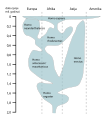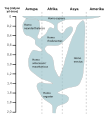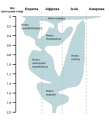File:Humanevolutionchart.svg

Original file (SVG file, nominally 303 × 335 pixels, file size: 91 KB)
Captions
Captions
Summary
[edit]| DescriptionHumanevolutionchart.svg |
English: Temporal and Geographical Distribution of Hominid Populations Redrawn from Stringer (2003).
This figure depicts one view of human evolutionary history based on fossil data. Other interpretations differ primarily in the taxonomy and geographical distribution of hominid species. The temporal distribution of the two divergent lineages of P. humanus is superimposed on the hominid tree to show host evolutionary events that were contemporaneous with the origin of P. humanus. Whereas the NW lineage is depicted on H. erectus in this figure, several alternative hypotheses are consistent with our data when other evolutionary histories of hominids are considered (unpublished data). The WW clade is shown in red and the NW clade in blue (see text for descriptions of clades). doi:10.1371/journal.pbio.0020340.g005Hrvatski: Temporalna i geografska distribucija populacija hominida precrtana iz Stringera (2003.).
Ova slika prikazuje jedan nazor o evolucijskoj povijesti čovjeka zasnovan na fosilnim podacima. Ostale se interpretacije primarno razlikuju u taksonomiji i geografskoj distribuciji hominidnih vrsta. Temporalna distribucija dviju divergentnih linija P. humanus superponirana je na hominidno drvo radi prikaza evolucijskih događaja u domaćina koji su bili kontemporarni s porijeklom P. humanus. S obzirom na novosvjetsku (NW) liniju prikazanu na H. erectus na ovoj slici, nekoliko mogućih hipoteza konzistentno je s našim podacima kada se razmotre ostale evolucijske povijesti hominida (neobjavljeni podaci). Svjetski proširena (WW) klada prikazana je crveno, a novosvjetska (NW) klada plavo (vidi tekst za opise klada). doi:10.1371/journal.pbio.0020340.g005 |
| Date | (UTC) |
| Source |
Reed DL, Smith VS, Hammond SL, Rogers AR, et al. (2004) Genetic Analysis of Lice Supports Direct Contact between Modern and Archaic Humans. PLoS Biol 2(11): e340. doi:10.1371/journal.pbio.0020340 http://www.plosbiology.org/article/info:doi/10.1371/journal.pbio.0020340 This file was derived from: Humanevolutionchart.jpg: |
| Author |
|
| Other versions |
[edit]
|
| This is a retouched picture, which means that it has been digitally altered from its original version. Modifications: vectorisation. The original can be viewed here: Humanevolutionchart.jpg:
|
Licensing
[edit]|
This file is licensed under the Creative Commons Attribution 2.5 Generic license.
|
This file was published in a Public Library of Science journal. Their website states that the content of all PLOS journals is published under the Creative Commons Attribution 4.0 license (or its previous version depending on the publication date), unless indicated otherwise.
|
File history
Click on a date/time to view the file as it appeared at that time.
| Date/Time | Thumbnail | Dimensions | User | Comment | |
|---|---|---|---|---|---|
| current | 10:10, 6 January 2015 |  | 303 × 335 (91 KB) | Conquistador (talk | contribs) | {{Information |Description ={{en|1=Temporal and Geographical Distribution of Hominid Populations Redrawn from Stringer (2003) "This figure depicts one view of human evolutionary history based on fossil data. Other interpretations differ primarily i... |
You cannot overwrite this file.
File usage on Commons
The following 13 pages use this file:
- User:Conquistador/gallery
- File:Human evolution chart-bg.svg
- File:Human evolution chart-el.svg
- File:Human evolution chart-en.svg
- File:Human evolution chart-fa.svg
- File:Human evolution chart-fr.svg
- File:Human evolution chart-he.svg
- File:Human evolution chart-hr.svg
- File:Human evolution chart-it.svg
- File:Human evolution chart-sv.svg
- File:Human evolution chart-tr.png
- File:Human evolution chart-uk.svg
- File:Humanevolutionchart.jpg
File usage on other wikis
The following other wikis use this file:
- Usage on en.wikibooks.org
- Usage on id.wikipedia.org
- Usage on ja.wikipedia.org
- Usage on lv.wikipedia.org
- Usage on nl.wikipedia.org
- Usage on pt.wikipedia.org
- Usage on sw.wikipedia.org
- Usage on uk.wikipedia.org
- Usage on vls.wikipedia.org
- Usage on yo.wikipedia.org
Metadata
This file contains additional information such as Exif metadata which may have been added by the digital camera, scanner, or software program used to create or digitize it. If the file has been modified from its original state, some details such as the timestamp may not fully reflect those of the original file. The timestamp is only as accurate as the clock in the camera, and it may be completely wrong.
| Width | 303.00024 |
|---|---|
| Height | 334.50024 |
















